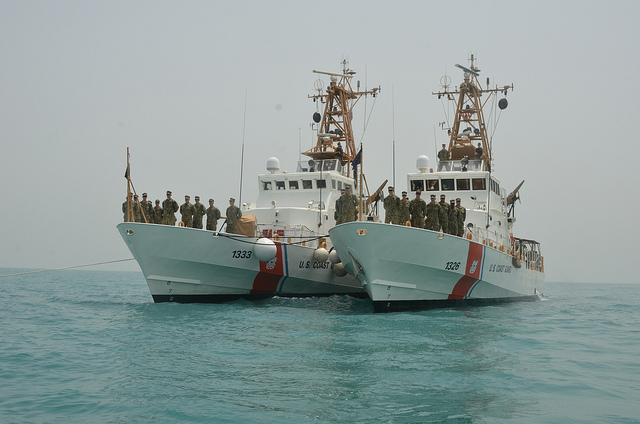Since 2009, China’s non-military maritime law authority vessels have engaged in low intensity coercive activities (PDF) designed to alter the status quo in China’s maritime periphery. Regional states have largely been at a loss as to how to deal with China’s growing maritime presence and, for its part, the US has been reluctant to physically insert itself into disputes for fear of militarising them unnecessarily. But there are signs of mounting frustration in Washington with the current state of affairs and America’s policy settings. And while analysts are right to point to the risks of escalation in any confrontation between the PLA and the US Navy, it’s increasingly clear that the US must do something, even if it means mirroring China’s own provocative practices.
In a recent Foreign Policy article Ely Ratner and Elbridge Colby argue that by foreshadowing the prospect of ‘penalties’ for coercive diplomacy in future, America can ‘inject a healthy degree of risk into Beijing’s calculus’, and discourage China’s destabilising behaviour. While Ratner and Colby aren’t forthcoming on what kinds of penalties the US should be willing to impose, it’s clear that directly threatening the use of superior force would be a risky option. China could quite easily ignore threats (whether implicit or explicit) and push the difficult choice of conceding or escalating back onto the US. China’s much heralded counter-intervention capabilities mean that America’s ability to impose substantial military penalties is heavily reliant on capabilities like stealth and long-range precision strike. Those capabilities are hard to leverage in threat-based contests because they are not visible until used against an adversary, in which case a conflict threshold has already been crossed. Rather, the US needs to find ways to contest China’s actions without unnecessarily escalating a crisis or making threats that can’t be honoured.
A good place to start would be choosing the right tools. China has developed the practice of deploying maritime law enforcement ships and wielding the implicit threat of naval vessels over the horizon. The US should mirror this practice. Deploying US Coast Guard vessels to the region, and possibly even basing them in the Philippines—perhaps joint crewing them with Manila—would enable the US to exert greater low-level presence in the maritime commons. This would greatly complicate Beijing’s current strategy and might enable the US to force a stalemate in some circumstances. Besides this operational effect, a greater presence would send important signals of support and commitment to regional states. A strategy aimed at achieving the limited objective of effective contestation is more plausible than a strategy aimed at eliciting a Chinese back-down.
Now it is not immediately evident that Coast Guard operations would be sufficiently intimidating to alter Chinese behaviour. But even low-level operations like this take on a quality Thomas Schelling described as ‘the threat that leaves something to chance’—this is an action that deliberately exploits the risks and uncertainties that accompany even low-level military action. Putting Chinese and American forces alongside one another in an adversarial setting increases the risk that, through accident or false alarm, the situation escalates. That type of threat can be more effective than a clear and direct one because its credibility rests on a dynamic which is partly independent of deliberate retaliation. So let the Chinese leadership fret about a breakdown in their control over the PLAN, or weigh the consequences of accidents at sea. That would make the risks of China’s coercive diplomacy all the more vivid.
As well as risks there would also be costs involved in ‘effective contestation’—it might involve actions that dilute the increasingly thin premise of American neutrality in Asia’s territorial disputes. That, in turn, might renew Southeast Asian states’ concerns about polarisation. But while those costs might be substantial, the costs of not turning up accrue steadily. China’s actions are already undermining the security architecture that has arisen organically in East Asia over the past decades. Unilaterally altering the balance of ‘facts on the ground’ directly flouts the stipulations of ASEAN’s Declaration of Conduct, as well as UNCLOS. Over time that’ll foster a less cooperative and more competitive regional order.
Perhaps just as important from an American point of view, China’s ability to bully its treaty allies with impunity saps American prestige. Prestige can be described as a reputation for power. America’s unwillingness to dirty its hands in low-level maritime coercion increasingly looks like impotence, and reinforces a stubbornly persistent narrative of American ‘weakness’. If the US wants to shake off the visage of a fading leviathan it will have to commit to the relevant level of conflict. Doing this in an effective and non-escalatory manner may require sending in the Coast Guard.
Daniel Grant is an intern at ASPI. Image courtesy of Flickr user US Coast Guard.


